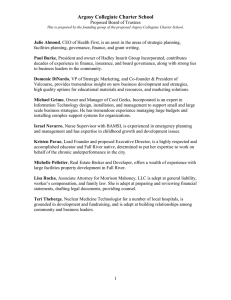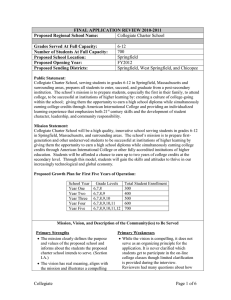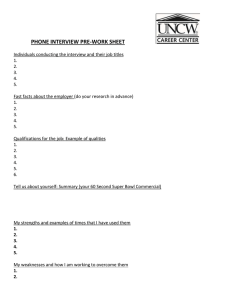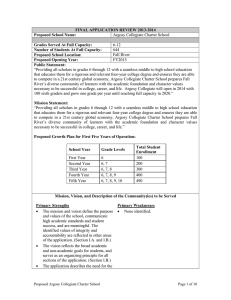item5 TabN appreview
advertisement
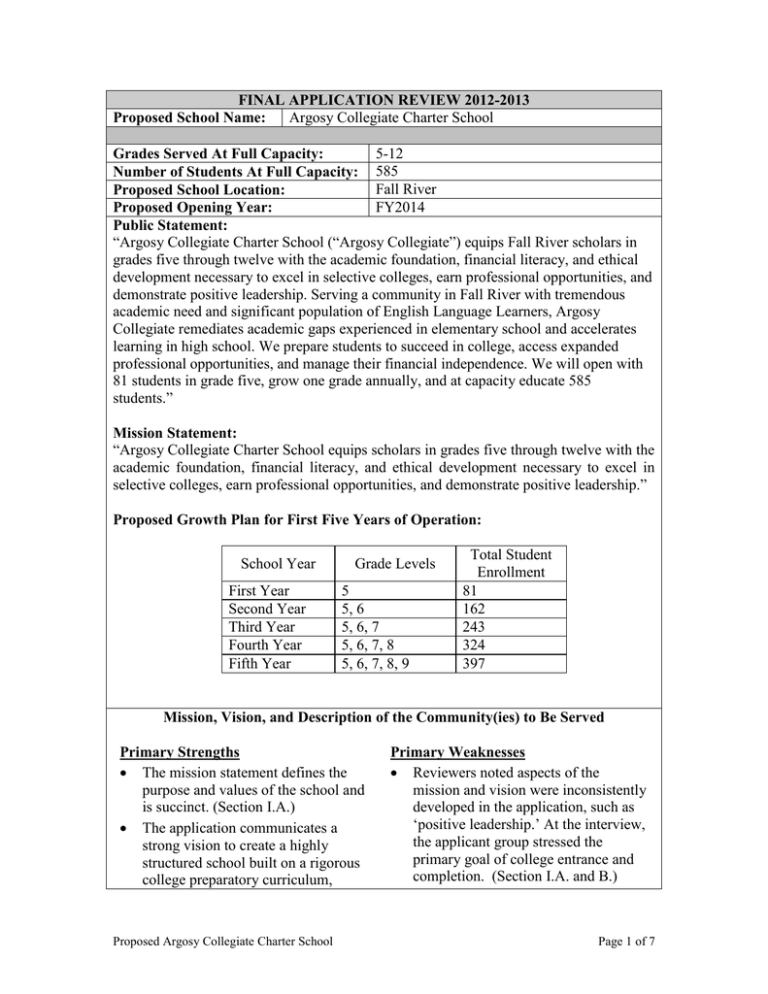
FINAL APPLICATION REVIEW 2012-2013 Argosy Collegiate Charter School Proposed School Name: 5-12 Grades Served At Full Capacity: Number of Students At Full Capacity: 585 Fall River Proposed School Location: FY2014 Proposed Opening Year: Public Statement: “Argosy Collegiate Charter School (“Argosy Collegiate”) equips Fall River scholars in grades five through twelve with the academic foundation, financial literacy, and ethical development necessary to excel in selective colleges, earn professional opportunities, and demonstrate positive leadership. Serving a community in Fall River with tremendous academic need and significant population of English Language Learners, Argosy Collegiate remediates academic gaps experienced in elementary school and accelerates learning in high school. We prepare students to succeed in college, access expanded professional opportunities, and manage their financial independence. We will open with 81 students in grade five, grow one grade annually, and at capacity educate 585 students.” Mission Statement: “Argosy Collegiate Charter School equips scholars in grades five through twelve with the academic foundation, financial literacy, and ethical development necessary to excel in selective colleges, earn professional opportunities, and demonstrate positive leadership.” Proposed Growth Plan for First Five Years of Operation: School Year First Year Second Year Third Year Fourth Year Fifth Year Grade Levels 5 5, 6 5, 6, 7 5, 6, 7, 8 5, 6, 7, 8, 9 Total Student Enrollment 81 162 243 324 397 Mission, Vision, and Description of the Community(ies) to Be Served Primary Strengths The mission statement defines the purpose and values of the school and is succinct. (Section I.A.) The application communicates a strong vision to create a highly structured school built on a rigorous college preparatory curriculum, Proposed Argosy Collegiate Charter School Primary Weaknesses Reviewers noted aspects of the mission and vision were inconsistently developed in the application, such as ‘positive leadership.’ At the interview, the applicant group stressed the primary goal of college entrance and completion. (Section I.A. and B.) Page 1 of 7 including a college skills program. (Section I.B.) The application describes the need for the proposed school, including evidence to support the demand for the school through a 600 signature petition in support of the proposed school. (Section I.C.) This charter application received letters and/or written testimony in support during the public hearing and public comment process, including but not limited to Senator Michael Rodrigues, Representative Alan Silvia, and Representative Patricia Haddad. See public comment. (Section I.C.) The charter application received letters and/or written testimony against the proposal, including but not limited to Fall River Superintendent Meg Mayo Brown. Additionally, two individuals have stated their support had been misrepresented in the final application. See public comment. (Section I.C.) Educational Philosophy, Curriculum and Instruction Primary Strengths Primary Weaknesses The educational philosophy describes The applicant group presented limited the founding group’s two core beliefs evidence of how the instruction and of integrity and accountability, as well curriculum would be accessible and as its seven values, including appropriate for all students at all exceptional teaching and a clear code levels. At the interview, the applicant of conduct. The philosophy aligns group described how the school’s use with and builds on the school’s of student assessment data would be mission. (Section II.A.) used to develop specific strategies for struggling students. (Section II.B.) The curriculum and instruction section are consistent with the mission and While in the interview, the applicant educational philosophy of the school. group explained in greater detail the The application includes a well process and procedures used to developed financial literacy evaluate curriculum effectiveness, to curriculum. (Section II.B.) inform professional development through “data days,” and to facilitate The proposed school leader seeks to ongoing development, improvement, replicate best practices from other “no and refinement of curriculum and excuses” schools. At the interview, the instruction, it remains unclear how proposed school leader described this will be actualized. (Section II.B.) working with other high performing schools during the planning year on curriculum development and alignment for the proposed school. (Section II.A.) Proposed Argosy Collegiate Charter School Page 2 of 7 Assessment System, Performance, Promotion, and Graduation Standards Primary Strengths The promotion and graduation standards are based on high expectations, and aligned with the proposed school’s mission and vision. (Section II.C.) The application explains how achievement data will be collected and managed; it also describes a variety of internally and externally developed assessments used to measure student progress, including Achievement Network (ANet), and weekly quizzes. (Section II.D.) The use of interim and trimester summative assessments will allow the school to identify trends and respond quickly to student, grade level, and school wide performance data. (Section II.D.) Primary Weaknesses The application describes the grading policy in terms of rubrics, letter, and percentage grading. At the interview, the group stated that the grading system was still evolving and that the mastery levels described in the application were a philosophical discussion. (Section II.C.) The application did not include adequate details of a meaningful and practical approach for measuring student progress towards attaining non-academic goals. (Section II.D.) The description of the assessment system provides limited information about the alignment of assessments to curriculum and state standards, as well as its use to make adjustments to the educational program and inform staff development, including the development of action plans for students and whole classes. (Section II.D.) School Characteristics Primary Strengths The proposed school will implement an extended year of 185 days and an extended day, with a shortened day on Fridays for teacher professional development. (Section II.E.) The application describes the proposed school’s culture and a clear plan to establish and reinforce the culture, including advisory, and community meeting. It includes an extensive behavioral philosophy and disciplinary plan that is aligned with the proposed school’s mission and vision, including implementation for a paycheck token economy at the Proposed Argosy Collegiate Charter School Primary Weaknesses The review panel noted concerns with the structure of the schedule for students in the proposed hour prior to dismissal. The application noted it could be spent as enrichment time, tutoring, homework completion time, or detention for grades 5-8. In grades 9-12, the blocks at the end of the day are for tutoring and homework, and enrichment and college skills programming. It remains unclear how the proposed programming would be supported and implemented for all students. (Section II.E.) The application provides limited Page 3 of 7 middle school grades. (Section II.E.) While it is not clear the exact methods or strategies that might be used to support students with a wide range of needs, in the application and in the interview, the applicant group emphasized that structured tutoring and enrichment provide individualized support. (Section II.E.) information on the school’s plans to involve parents/guardians as partners in the education of their children and the potential external programs that will be brought into the school. (Section II.E.) While reviewers noted that the teacher and student school day descriptions were provided a full sense of the proposed school in great detail, the panel noted concerns about teacher expectations, including riding the school bus provided by the district with students in the morning. (Section II.E.) Special Student Populations and Student Services Primary Strengths Primary Weaknesses In the application and interview, the The application provides generalized applicant group provides insufficient information on the policies and information to establish their capacity procedures for serving students to adequately serve students with identified as English Language disabilities and ELLs, and lacks an Learners (ELLs). The application individual with professional expertise demonstrates knowledge of the in implementing an English Language requirements to implement a Sheltered Development or special education English Immersion (SEI) program. program. (Section II.F.) During the interview, the applicant While in the application, the applicant group clarified the use of the group provides limited information appropriate assessments to be used about the qualifications of individuals with ELLs. (Section II.F.) who will implement the ELD program, during the interview, the applicant group indicated the intent to hire reading and writing teachers who were dual licensed in ELL instruction. The staffing chart indicated for the first year of operation: one ELL (ESL) teacher, and one part time individual performing the administrator and teacher responsibilities for the special education program. During the interview, the applicant group indicated that the special education staffing plan has evolved to have one Proposed Argosy Collegiate Charter School Page 4 of 7 full-time special education teacher during the first year supported by the Director of Academic Achievement. (Section II.F.) Enrollment and Recruitment Primary Strengths At the interview, the group clearly articulated the need for slow enrollment growth as integral to the successful implementation of the school model. The proposed growth model maintains consistent enrollment per grade over time and allows for attrition in the upper high school grades. (Section III.A.) Primary Weaknesses While the application narrative contains some of the required elements, the submitted draft enrollment policy does not reflect the most recent Department guidance (August 2011) on required elements of enrollment policies and implementation practices. (Section III.A.) Capacity and School Governance Primary Strengths Primary Weaknesses The proposed board members have a The proposed board lacks a member range of experience and qualifications, with an education background to assist including management, health care, in monitoring the proposed school’s real estate, and law. (Section III.B.) academic performance and the school leader’s effectiveness in developing The governance model presents a and implementing the proposed clear workable structure and academic program. (Section III.B.) encourages an appropriate relationship between the board of trustees, school The submitted draft bylaws do not leader, and administration regarding reflect the most recent Department governance and management of the guidance (February 2011) on required school. (Section III.C.) elements of board of trustee bylaws. The draft bylaws omit a number of the The application identifies criteria for required elements and indicate the use the selection and evaluation of a of prohibited practices such as proxy school leader. At the interview, the voting. (Section III.C.) proposed board was able to articulate the reasons for the selection of the proposed leader, Kristen Pavao. (Section III.C.) BES’ “Connect to Excellence” program will provide three levels of support for board development: ensuring that that there is a process for recruiting new board members; Proposed Argosy Collegiate Charter School Page 5 of 7 assisting with strategic planning; and general board development. (Section III.C.) Management Primary Strengths The application provides a clear reporting structure narrative. General teaching goals are articulated, and teacher supervision and evaluation procedures are outlined in the application. (Section III.D.) Professional development is clearly described in this section with two focus areas: classroom, and school culture; and curriculum, instruction, and assessment. The professional development schedule includes a 3 week summer institute, weekly Friday afternoons, and 12 full days during the school year. (Section III.D.) There are descriptions of clearly delineated roles and responsibilities for the school leader and other administrative staff. (Section III.D.) BES’ “Connect to Excellence” program will provide on-going support for school leadership including but not limited to the development of the hiring process for staff; cultural audits; and review of assessments. Additionally, the fellowship has provided the proposed leader with access to a network of schools to assist in curriculum development. (Section III.D.) Proposed Argosy Collegiate Charter School Primary Weaknesses While the proposed school leader has not previously held a school leadership position, Ms. Pavao possesses professional qualifications in both elementary and secondary education, and possesses six years of experience as a middle school teacher in both a district and charter school in Fall River. Ms. Pavao has previous management experience in retail, and hospitality industries. (Section II.E.) The application provides limited information regarding the teacher evaluation system beyond the schedule of observations. (Section II.E.) Page 6 of 7 Facilities, Transportation, and Finances Primary Strengths The application provides a structure and process for managing school finances with a specific outline of fiscal controls. There is a clear plan for how the school will track finances in its daily business operations. (Section III.E.) At the interview, the proposed board indicated their commitment to fundraising. The applicant group has the financial support of the Amelia Peabody Foundation for the planning year if federal charter school planning grants are unavailable. (Section III.E.) The applicant group has identified a number of potential buildings for the location of the school in the desired neighborhood. (Section III.F.) Proposed Argosy Collegiate Charter School Primary Weaknesses The proposed budget was written without any proposed board input or review. The proposed budget used incorrect sources of information for calculating the per pupil tuition, resulting in a significant overestimation of revenue. During the interview, the applicant group was able to explain what adjustments would be made to address the significant discrepancies in funding. However, in order to do so, staffing and materials to support the proposed school design were significantly impacted. (Section III.F.) Page 7 of 7
